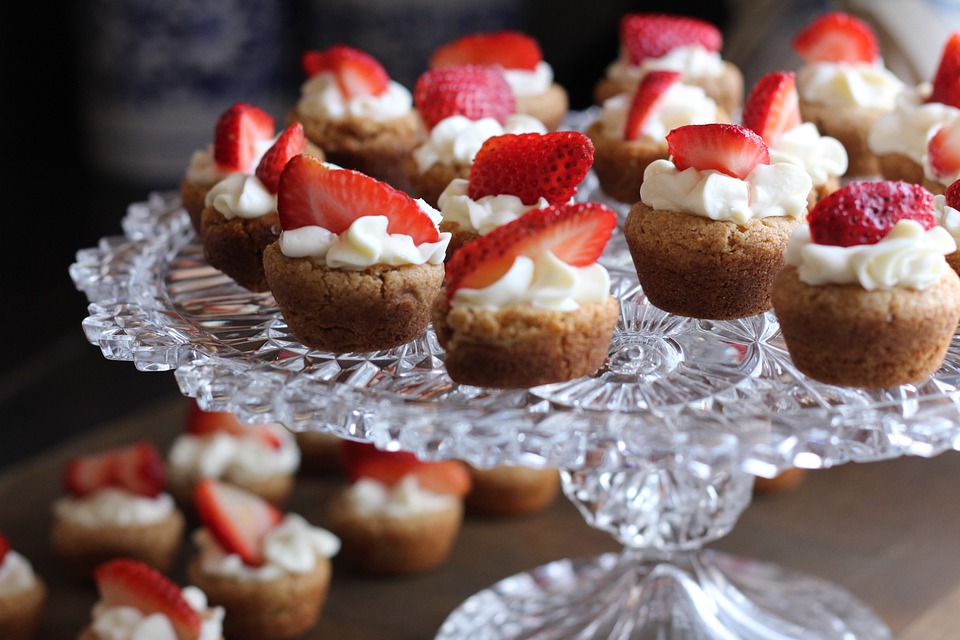
“Eating with awareness is the most important and powerful tool to transform your relationship to food and the body.”
~ Marc David
Paleo Cupcakes, Cookies and Pies, Oh My!
Treats are a point of controversy in the paleo community. Some people point out that our ancestors never baked and had limited access to sugar, natural or otherwise. Others say that if paleo is designed to be a diet for life, we need it to be sustainable in modern life, and some days we just want a cookie. So, who is right? In the autoimmune community, this is an even more important question. We aren’t following paleo to simply optimize good health; we’re trying to reverse autoimmune disease, which is infinitely harder. The truth is, our bodies behave very differently than those without autoimmune disease, and sugar can have a bigger impact on our system than the general population. So, let’s look at all aspects of this question.
According to SugarScience.org, Americans consume an average of 66 pounds of added sugar per year. This isn’t the sugar naturally contained in fruits and vegetables. This is sugar added to packaged foods. Since most people on a paleo diet avoid packaged foods, we’re thankfully making healthier choices. However, we still need to be mindful of how much sugar (natural or otherwise) we choose to add to the paleo foods we do eat. We also need to watch out for the growing market of paleo packaged treats.
What Is Sugar?
Sugar is a carbohydrate found naturally in most plants. There are many ways human beings have found to extract and isolate it over the years, but what is sugar at its basic level? It’s made up of two molecules: glucose and fructose. When you combine them, it’s called sucrose. Glucose is a natural energy source for our bodies, and it’s one of the reasons human beings naturally crave sweet things. In ancestral times, it led us to want to eat the fruits and vegetables that provided us with this energy. The body can use glucose immediately, or it can store it in our muscles and liver as glycogen for later use. Insulin regulates what gets used vs. what gets stored. Fructose cannot be used immediately. It needs to be converted into glucose by the liver, and when we consume too much, it gets converted into fat. Sucrose is the combination of these two things, so it has an extra step in the digestion process – it first needs to be separated into glucose and fructose, and then it is used or stored accordingly.
“Paleo” Sugars
There are over 60 different names for sugars on conventional packaged food labels. Here are the less refined sugars that you might see in paleo dessert recipes:
- Dried fruit
- Date sugar
- Raw honey
- Pure maple syrup
- Maple sugar
- Molasses
- Coconut/Palm sugar
- Sucanat/Evaporated cane juice
Some of these start out as sucrose, but after digestion they all break down to pretty much 50% glucose and 50% fructose, which ironically is the same ratio as refined white sugar. So why are these considered potentially paleo? On the plus side, they don’t come from GMO crops, they aren’t heavily refined, and they contain some trace vitamins and minerals. But let’s be honest – they aren’t health foods. The body will still identify these as sugar and react accordingly.
Sugar’s Impact on the Body
Since glucose is a natural energy source for our bodies, human beings are designed to eat a certain amount of sugar in the form of fruits and vegetables. They’re good for our health. The problem comes when we eat too much. We can do this by bingeing on fruit or desserts. When we consume more sugar than our body needs:
- Inflammation rises, which can exacerbate autoimmune symptoms.
- Blood sugar goes out of balance, which also affects autoimmune expression.
- Insulin resistance develops, which can lead to obesity, diabetes, heart disease and even cancer.
- Free radicals increase, causing oxidative stress bodywide.
- The liver becomes overworked, which can lead to fatty liver disease.
- Microbial balance shifts, leading to small intestine bacterial overgrowth and gut dysbiosis.
What the Paleo Health Leaders Say
“Blood sugar fluctuations, whether someone misses a meal or someone eats too much, actually trigger the autoimmune inflammatory pathway. That’s why it’s important to stabilize your blood sugar levels, because it can determine if you progress or go into remission.”
“Sugar is sugar and will feed the wrong bacteria in the gut. I recommend limiting sugars, which is why I prefer non-starchy vegetables and limiting fruit. If a person is lean, the fruits may be better tolerated. If overweight, I recommend limiting to one serving or less per day. I discourage the use of fructose based sweeteners (agave, maple syrup, coconut sugar, honey etc.) as they increase the risk of dysbiosis, fatty liver, metabolic syndrome, glucose intolerance, and diabetes. I recommend limiting sugar intake, to 1 teaspoon or less per day. Better to wean away from the sweet taste preference that we all have.”
“Naturally sweet whole foods, such as fruits, berries, beets, carrots, and sweet potatoes, most definitely have a place on an autoimmune protocol diet. They diversify the diet, providing beneficial fiber and nutrition; and the natural sugars they contain are beneficial to glycemic regulation and metabolism. However, ‘the dose makes the poison.’ Generally speaking, added sugar is almost always harmful.
Sugar is especially likely to be harmful in autoimmune disorders, because “disease begins in the gut” as Hippocrates said. Autoimmunity is commonly caused by bacterial infections or overgrowth in the small intestine, in which partially digested food compounds are incorporated into bacterial cell walls and then the immune system, reacting to the bacteria, forms antibodies that also recognize food compounds, some of which might cross-react with human counterparts.
So added sugar should generally be avoided. If sweeteners are used, then they should be limited to a tablespoon per day of raw honey (which has antimicrobial compounds) or of dextrose powder (which lacks fructose and is more readily absorbed). When eating food products with added sugar, limit the sweetness; for instance, chocolate should be 85% cocoa or higher.”
“I advocate a return to natural sources of sweetness, mainly fruit and even vegetables. When fruit becomes your dessert, your taste buds will quickly adapt, and it won’t be long before fruit tastes like a decadent treat even though you are consuming a food rich in antioxidants, vitamins and minerals.
However, we are human. We still want to celebrate birthdays and job promotions with food. The point of the Paleo Approach is not to deprive you of the joys of food or the celebrations of life, but to get you healthy. If you who want to try your hand at some baking, [understand] that this should be reserved for special occasions.”
Sarah’s preferred sweetener is blackstrap molasses, due to its nutrient-dense profile.
The Consensus
While there are some nuanced differences in the answers above, all agree that sugar impacts autoimmune expression, and even natural sweeteners should be limited. The goal is to wean ourselves away from our sweet tooth. Once we do that, even vegetables can begin to taste sweet.
5 Tips for Healthy Dessert Choices
- Choose fresh fruit with optional coconut whipped cream. Berries are among the most nutrient-dense fruit choices, containing large amounts of antioxidants. They are also low on the glycemic index, meaning they have a minimal impact on blood sugar.
- Baked fruit increases the sweetness without increasing the sugar content. It does this by evaporating some of the water fresh fruit contains. Cook it with a healthy fat, sprinkle a little cinnamon or ginger on top, and enjoy a warm dessert on a cold, winter day.
- Are you an abstainer or a moderator? When it comes to sweet desserts like cake, cookies and ice cream, for many people, one taste makes them want more and more. In that case, the best way to wean yourself away from your sweet tooth is to avoid these recipes altogether. However, if you’re someone who is able stop at one cookie and feeling forbidden makes you rebel, then keeping a small stash of paleo desserts in the freezer might be the right choice for you.
- If you decide to make a paleo treat, ideally look for recipes that have a maximum of 1 tablespoon added sugar per serving. There are literally thousands of paleo dessert recipes on the internet now, and they vary widely in the amount of sweetener added. People seem to think that as long as it’s an unrefined sugar, the amount doesn’t matter. I’ve seen paleo recipes with 2 cups of sugar added for 1 dozen muffins, vs. ones made with no added sugar at all. Start choosing the low-sugar recipes and let your taste buds adapt. If you have seen a high-sugar paleo dessert you really want to try, save it for a once-per-year special occasion like your birthday. Over time, you’ll likely find your birthday cravings start to change. Mine have!
- Always eat your dessert with a meal, to moderate the blood sugar effect. When we eat sugar by itself, it causes an immediate blood sugar spike, and as Dr. Kharrazian says above, that can lead to autoimmune flares. When we eat it alongside a meal with protein, fat and fiber, that moderates the blood sugar response. If you have a little apple cider vinegar in a small glass of water after your meal, that helps moderate blood sugar as well.
You May Also Be Interested In
A version of this post originally appeared in my column in Paleo Magazine.
Credit: image at top of page from Pixabay.

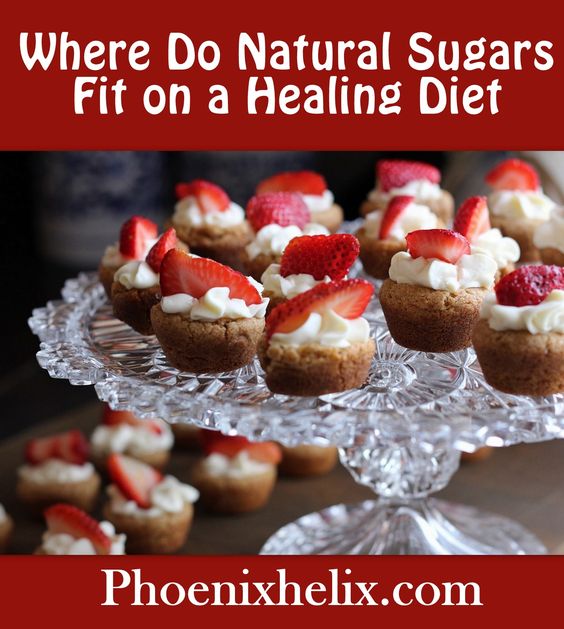
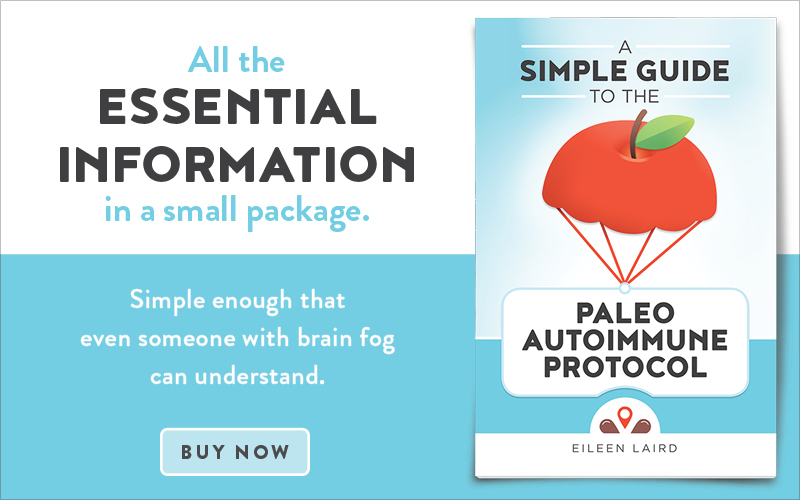






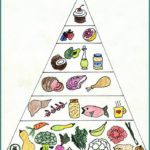
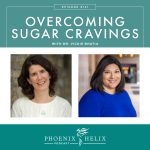
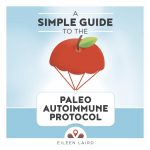


I want to know about monk sweetener..
Hi Elena. It’s not recommended. It’s actually an immune system stimulator, which isn’t recommended for people with autoimmune disease. Sarah Ballantyne writes about low-calorie sweeteners in this article. The summary is that there is no way to cheat desserts. It’s better to use natural sugars in moderation than to try to eat desserts more frequently with low-calorie sweeteners: https://www.thepaleomom.com/paleo-splenda-erythritol-stevia-low-calorie-sweeteners/
What about pure stevia with no other ingredients is this ok on a low carb, healing, paleo diet? What about maltodextrin?
Hi Glen. Definitely no on maltodextrin. It’s a processed sugar usually derived from non-paleo ingredients like wheat and corn. As for stevia, Sarah Ballantyne recommends against it altogether. Terry Wahls has said that the stevia leaf is OK in small quantities, but not the refined liquid extract.
What do you think of the sweetener Monk Fruit? I don’t see it mentioned here. Will that be ok?
thank you
Hi Jill. It’s not recommended because it stimulates the immune system (something we need to be cautious of when we have autoimmune disease.)
great resource! I’ve been haphazardly putting together a list of things labeled ‘immune system stimulant’ but I’m sure it is not as thorough as it could be. Have you come across a post (or have one yourself) of a comprehensive list?? I’d like to avoid anything that will aggravate symptoms or stoke the fires of inflammation. Thanks! 🙂
Hi Jess. That would be a great resource, but I don’t know of one, and it would be very long. One way to add to your list is to Google “Th1 stimulant” and “Th2 stimulant”, and you’ll find lots of things. Autoimmune disease is usually dominant in one of those two directions (Th1/Th2). If you know your own dominance, you can avoid the one kind and experiment with the other. Here’s an article about that balance that includes some of the stimulants: http://autoimmune-paleo.com/how-do-you-balance-th1-and-th2-in-autoimmune-disease/
Dear Eileen,
What do you think about yacon syrup?
Best wishes
Hi Hubert. It seems to be similar to coconut sugar in that it’s high in inulin fiber. Many people with autoimmune disease have digestive problems if they eat too much of that type of fiber. For that reason, Sarah Ballantyne recommends using other natural sugars instead. But as you can see by the article above, the goal is to limit added sugars overall and wean ourselves away from that sweet tooth. There is no type of added sugar that will get a seal of approval to eat freely.
I went through a rebellion two months ago and ate things I shouldn’t. Now i’m paying the price. Lots of pain and suffering. Just now getting myself back to feeling better. Still have away to go. I can only tolerate small mounts of fruits because of my diabetes got out of control. Staying in control is very important . Your letters have given me some insight in how to stay focused because lots of my issues are mind over matter. Reading your article on sugar and how it affects our bodies was inlighting. Sugar is my biggest down fall.
Thanks for sharing your experience, Cindy. The mindbody piece if huge for us all. Sending a gentle hug your way and hoping your suffering passes quickly.
I love exploring Paleo baking, and we have techniques for not going overboard – such as baking a batch of muffins and putting most of them in the freezer. I use muscovado sugar, but no more than 1/3 cup for 9 muffins or a cake. It’s amazing how our tastebuds have changed. I’ve followed Paleo recipes and just found them way too sweet. I’ve written a couple of posts on this topic – Why You’ll Never Kill the Sugar Dragon – and – How to Keep Him Under Control – and I truly think that the trick, for everyone, not just those with AI, is to retrain the tastebuds and the mind, remembering that a Treat is a Treat. And a Whole 30 a couple of times a year is so effective for transforming that Dragon into a submissive lizard.
Angie, thanks so much for sharing your experience. It sounds like you have a healthy relationship with sugar.
This is one of the reasons I’ve never gotten into paleo or AIP baking. I know me, and as a recovering sugar-junkie, that stuff spells trouble, even if it’s “natural.” I do occasionally use raw honey and maple in recipes (usually savory ones) but my go to sweet treat is frozen berries. A great post on an important issue.
Thanks for sharing your experience, Kat. It sounds like you’re an abstainer. Like you, my taste buds have really changed since going paleo. I love berries, too! One of my favorite treats is similar to yours – frozen berries blended with coconut milk, with no added sugars.
i have noticed so many paleo recipes full of sugar! it drives me nuts when bloggers label something “sugar free” but it still uses a cup of honey or coconut sugar. i wish people were more educated on the effects of all sugar on the body. luckily, i am able to enjoy dessert/treats daily because i am in remission and still thin. i don’t like depriving myself of dessert because i will binge on it if i label it as a “naughty” food. i just make sure that it is still full of nutrients and i eat it with fat and protein.
It sounds like you’re a moderator, Joanna. The key is knowing ourselves. I’m so happy that you’re in remission!